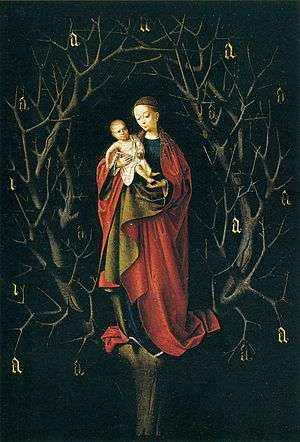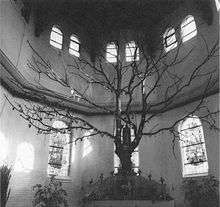Madonna of the Dry Tree

Madonna of the Dry Tree (or Our Lady of the Barren Tree) is a small oil-on-oak panel painting dated c. 1462-5 by the Early Netherlandish painter Petrus Christus. Unusually innovative and dramatic for the time, it shows the Virgin Mary holding the Christ Child as she stands on a disembodied dead tree trunk, surrounded by the circular briars of a crown of thorns, giving the work a haunted, spectral air.
The painting seems to reference im imagery from the Book of Ezekiel, with the tree a representation of the Tree of Knowledge from the Garden of Eden, which had run dry and withered, but flowered again with the birth of Christ. The golden letters hanging from the branches of the tree probably represent the first letters of the Angelic Salutation, the Ave Maria.[1] The lord is presented as holding an orb, and crowned with the cross. The iconography is drawn from the "Confraternity of Our Lady of the Dry Tree" of Bruges, of which both Christus and his wife, Gaudicine, were members. The Franciscan chapel of the Minorites that they worshiped at was destroyed during the wave of iconoclasm that swept through Northern Europe in the 1570s.
Description

Mary is dressed in a long red robe with a green lining, the folds deeply cut in an almost sculptural manner. Her robe closely resembles that of the Madonna in Christus's Exeter Madonna of c. 1444,[2] leading to speculation that the work is from an earlier period than the assumed c. 1462-65. Unusually for a Madonna of the time, her face is largely unidealised, the features less soft or rounded, and her expression less presupposing than in his later Madonnas or even secular female portraits.[3]

The representation of Christ seems derived from Rogier van der Weyden, especially in the playfulness and amiability of Christ's facial expression, although given that Christus might not have had access to the older master's work, the influence may be second-hand, through the panels of Hans Memling. The panel is highly illustionistic, perhaps on par with the older painter's Durán Madonna. Christus employs trompe-l'œil techniques in a number of passages, creating a three-dimensional effect that adds to the strangeness and disembodied atmosphere. These can be most notably seen in the Virgin's hand as it lies below the child's toes, in the orb held in his hands, and in the golden letters hanging from the tree briars.[2]
X-radiograph reveals little preparatory underdrawing outside of a series of ruled lines used to situate elements within the overall design. Maryan Ainsworth notes that this is typical of Christus's smaller panels, some which – including this work – could be considered miniatures, and compares it to the techniques used with contemporary illuminated manuscripts.[4]
Iconography

Art historian Grete Ring identified the iconography of the work as belonging to the Bruges confraternity of "Our Lady of the Dry Tree" of which Christus was a member,[6] also known as the "Confraternity of Our Lady of the Snow". The confraternity attracted members of the upper echelon of Burgundian society; Philip the Good's wife Isabella of Portugal was a member as were most of the leading Burgundian nobles, the leading upper-class families and the leading foreign traders of Bruges.[7] Christus joined – for the same reason Gerard David would some years later - to attract wealthy patrons,[7] sometime between 1458 and 1463.[8]
The confraternity, first documented in 1396 but almost certainly established earlier, met at the Bruges Franciscan friary in a private chapel with its own altar.[8] Its popularity waned after 1515; the friary was destroyed in 1578 during the religious wars. In the 17th century the confraternity moved to Eeckhout abbey. It was dissolved in 1821.[8]
According to its history, written in the 17th century, Philip the Good established the confraternity when he won a battle against the French after praying to an image of the Virgin he saw on a dry tree. However, the confraternity was already in existence when Philip was born; yet the story holds a germ of truth, because trees with images of the Virgin were commonly venerated, according to Hugo van der Velden.[9] The tradition of suspending a Marian image from a tree originated as early as the fifth century and represented a blending of pagan and Christian worship. The trees with their venerated images were common, and would have been recognized as landscape markers. Other similar trees and images were Our Lady of the Oak and Our Lady of the Cherry.[10]
According to van der Velden the iconography is unusual;[11] Ainsworth writes it is unprecedented in Netherlandish painting.[1] It is thought to form its basis from text in Ezekiel 17:24; "and all the trees of the field shall know that I the Lord have brought down the high tree, have exalted the low tree, have dried up the green tree, and have made the dry tree to flourish".[1] The formation can be read as a somewhat bitter representation of the "Tree of Knowledge", but wilted and thorn ridden, presumably because of original sin, and which will only return to life on the coming of Christ.
The 15 letter "A"s hanging from the tree are generally seen as abbreviations for Ave, or Ave Maria. Their number may to be an allusion to the 150 "Hail Marys" recited in then-contemporary versions of the rosary, although this form of devotion did not become popular until 1475, some ten years after Christus's panel.[12] Two other interpretations for the "A"s have been put forth. One is that they symbolize arbor or arbore, as other similar devotional works show the trees in an arbor. Hugo van der Velden suggests the possibility that the piece might have been commissioned by a member of the confraternity, Anselme Adornes, a man interested in devotional work evidenced by his possession of van Eyck's Saint Francis Receiving the Stigmata.[13]
Influences and provenance
The panel influenced Peter Claeyssens the Younger's 1620 triptych Our Lady of the Dry Tree, which drew from the same sources and is equally dark in tone and theme, but lacks the dramatic impact of Christus' panel.[8]
The painting was first recorded in a private collection in Belgium before 1919. It was acquired by the Museo Thyssen-Bornemisza, Madrid in 1965.[1]
Notes
- 1 2 3 4 Ainsworth (1994), 162
- 1 2 Ainsworth (1994), 164
- ↑ Ainsworth (1994), 161
- ↑ Ainsworth (1994), 103; 115
- ↑ van der Velden, 98
- ↑ "The Virgin of the dry Treeca. 1465". Museo Thyssen-Bornemisza. Retrieved 18 March 2013.
- 1 2 Ainsworth (1998), 34
- 1 2 3 4 van der Velden, 91
- ↑ van der Velden, 95
- ↑ van der Velden, 98-99
- ↑ van der Velden, 89
- ↑ van der Velden, 108
- ↑ van der Velden, 109
Sources
- Ainsworth, Maryan. Petrus Christus: Renaissance Master of Bruges. New York: Metropolitan Museum of Art, 1994. ISBN 0-8109-6482-1
- Ainsworth, Maryan. "The Business of Art: Patrons, Clients and Art Markets". Maryan Ainsworth, et al. (eds.) From Van Eyck to Bruegel: Early Netherlandish Painting in the Metropolitan Museum of Art. New York: Metropolitan Museum of Art, 1998. ISBN 0-87099-871-4.
- van der Velden, Hugo. "Petrus Christus's Our Lady of the Dry Tree". Journal of the Warburg and Courtauld Institutes, Volume 60, 1997.
| ||||||||
